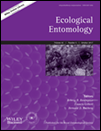Ver ítem
- xmlui.general.dspace_homeCentros Regionales y EEAsCentro Regional Patagonia NorteEEA BarilocheArtículos científicosxmlui.ArtifactBrowser.ItemViewer.trail
- Inicio
- Centros Regionales y EEAs
- Centro Regional Patagonia Norte
- EEA Bariloche
- Artículos científicos
- Ver ítem
Sex, life history and morphology drive individual variation in flight performance of an insect parasitoid
Resumen
1. The movement of organisms can be driven by multiple factors and has implications for fitness and the spatial distribution of populations. Insects spend a large proportion of their adult lives foraging by flying for resources; however, their capability and motivation to move can vary across individuals.
2. The aims of this study were to examine interindividual and sex differences in flight performance and flight characteristics, using a flight mill
[ver mas...]
1. The movement of organisms can be driven by multiple factors and has implications for fitness and the spatial distribution of populations. Insects spend a large proportion of their adult lives foraging by flying for resources; however, their capability and motivation to move can vary across individuals.
2. The aims of this study were to examine interindividual and sex differences in flight performance and flight characteristics, using a flight mill bioassay, in Megarhyssa nortoni (Hymenoptera; Ichneumonidae), a parasitoid of the invasive woodwasp Sirex noctilio (Hymenoptera: Siricidae), one of the most important pests of pine afforestation worldwide. We also assessed the influence of morphological traits in combination with sex on flight and explored the cost of flight on longevity and mass loss.
3. The results show a difference between sexes in flight characteristics and performance. Females show greater total distance flown than males, and have a better capacity to undergo sustained flight. Sexual size dimorphism was also found and it was noted that size positively affects distances travelled. Females have a longer life span than males, yet no differences were noted in longevity within sex between individuals that did not fly and those that flew. Age did not influence flight performance of females or impacted on post-flight longevity. Females lost less body mass than males even after flying longer distances.
4. These results suggest that sex-specific behaviours probably govern flight abilities together with (and not only because of) morphological traits. The paper discusses sex-specific life-history strategies in parasitoids and their implications for biocontrol programmes.
[Cerrar]

Fuente
Ecological entomology : 1-9. (2017)
Fecha
2017-08
ISSN
0307-6946 (Print)
1365-2311 (Online)
1365-2311 (Online)
Formato
pdf
Tipo de documento
artículo
Palabras Claves
Derechos de acceso
Restringido
 Excepto donde se diga explicitamente, este item se publica bajo la siguiente descripción: Creative Commons Attribution-NonCommercial-ShareAlike 2.5 Unported (CC BY-NC-SA 2.5)
Excepto donde se diga explicitamente, este item se publica bajo la siguiente descripción: Creative Commons Attribution-NonCommercial-ShareAlike 2.5 Unported (CC BY-NC-SA 2.5)

